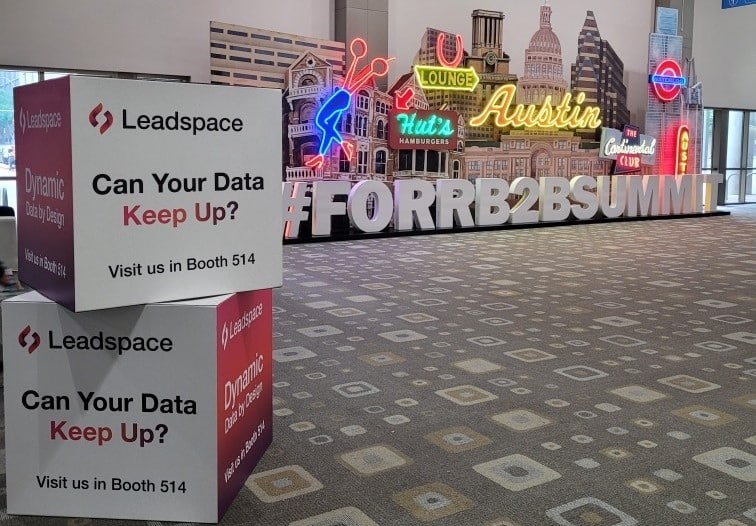Last week our team had the privilege of attending the Forrester B2B Summit 2024 in Austin, Texas, and it was one heck of an experience. If you took the time to attend the event, odds are that you saw the Leadspace team hustling at our booth or across the show floor in our awesome shoes – but we know that it’s our approach to data profiling that really grabbed your attention. Wherever we met you at the event, we truly enjoyed telling you about Leadspace and learning what kinds of problems sales and marketing teams are facing when it comes to operationalizing B2B buyer data. We posed a question on the wall of our booth, “Can your data keep up?” We wanted B2B sales and marketing teams to realize that no, they’re data cannot keep up – without Leadspace.
While we mainly went to Forrester to show off Leadspace and release new offerings, a major goal was to understand what data problems keep sales and marketing teams up at night. We noticed three main issues that sales and marketing teams are facing and want to address:
- Not getting the expected value from their buyer data
- Keeping buyer data up-to-date in light of moved jobs and, as a result, accounts
- Understanding buying groups and mapping hierarchies of target accounts
What we learned from other attendees:
Most attendees we spoke with indicated that they’re not getting enough value from their data in terms of identifying closeable business – even after implementing AI-scoring models. People with this problem had something in common: their data environment is a mess – duplicates, missing cells, silos, out-of-date data. The fact is, creating and distributing highly-personalized content at scale depends on an accurate foundation of buyer data. People are realizing that scoring models and other means of data-driven decision making are falling short because the underlying data just isn’t ready for AI-modeling. Their models are pointing them in the wrong direction, causing them to distrust their data all together – but it’s not the models’ (or even the data’s) fault. It’s a fundamentally flawed organizational system for buyer data that’s to blame. Those who understand this are aiming to clean up their buyer data environment, especially within their CRMs so that they can effectively automate their funnel and prioritize the right leads at the right time. Unfortunately, they’re struggling to merge numerous static data sources. They need a way to automatically ingest and unify all of their first- and third-party data and keep it up-to-date within their CRMs and MAPS.
The next big concern we noticed is around keeping buyer data up-to-date in the face of moved accounts and the technical debt acquired by systems not being up-to-date. People change companies every day, but sales and marketing teams have no idea when that happens. People are chasing down leads at the wrong company and blame the data for the resources spent pursuing a bad lead. Unfortunately, this is the reality of manually combining static data into your system – it’s still static! How do you even know when your buyer data is outdated? Updating data across your system every week would be incredibly expensive, tedious and time consuming – so much so that sales and marketing teams often don’t even bother. They need a way to automatically keep their data up-to-date. They want truly dynamic data.
The third major point of focus for sales and marketing teams is on identifying buying groups. Sales and marketing teams are realizing that it takes more than a title-match/keyword match to hone in on the right audience. Generally, it’s not just one person making decisions at an organization, and the buying power of a specific job title will differ between organizations. There is an entire team at each organization with different roles and responsibilities in the buying process, and highly-precise targeting requires understanding each person’s place in that team. Who do they answer to? What kind of buying power do they have? What are their specialties and expertise? What kind of problems are they responsible for solving? To truly know that a person is the right person, you need to understand where they sit in their organization’s hierarchy. Additionally, leads go cold after a day or two, so figuring out what territory someone is in too slowly can kill what would’ve been an amazing opportunity. If we can understand the structure of their organization, we can quickly identify the person within their organization who we need to talk to in order to make the deal happen. Predictive algorithms, firmographics, demographics, technographics, and intent are invaluable signals to identifying the people who need your product. However, their organizational hierarchies are the context that really matters when it comes to closing a deal. Unfortunately, merging a bunch of static data together in a spreadsheet or your CRM won’t paint a picture that lets you explore and map hierarchies from individuals up to their global ultimate. Thus, sales and marketing teams are looking for a solution that allows them to understand the hierarchies of the leads they target.
Key takeaway:
While most sales and marketing teams feel inclined to pursue data-driven decisions, it’s clear that many haven’t been seeing the results they’ve expected from various solutions. They’re losing trust in their data because they haven’t had the chance to truly experience the power of their data. While I would never wish these problems on anyone, it was very encouraging to hear that the most common data problems people face are the very ones that Leadspace aims to address with our approach to dynamic data.
How I explain it:
What sets us apart from other data providers is that we’re not another static database. Leadspace ingests all of your existing first- and third-party data, enriches it with our 30+ embedded third-party sources and unifies it all, automatically creating buyer profiles for people, companies and accounts with hierarchies. Each field cross-references 2-6 different sources for the most accurate value and are automatically updated as people and companies change, ensuring you’re relying on the most up-to-date, accurate buyer data available. Discover your ICP, explore your TAM, build your segments for activation. Our direct integrations with Salesforce and Marketo ensure you have all the firmographics, technographics, intent and hierarchy data you need at your fingertips, right there in your CRM and MAP systems. How do we do it? With our best-in-class (according to Forrester) Identity Resolution framework for mapping data to the correct buyer profiles. We also offer AI-models for Lookalikes, Fit / Propensity, Intent / Metro-Intent, and Persona/Buying Team scoring. Leadspace brings your static data to life – say goodbye to stagnant data!
What else we introduced:
Beyond promoting our dynamic data solution, we revealed our newest offering at Forrester – B2B MAPS. Understand and visually explore your B2B target market inside and out. Leadspace B2B Market Activation Packs (MAPS), are the industry’s first visual profiling solution to explore, map and activate 360 degree slices of the most popular territory/audience segments. Leadspace B2B MAPs leverage a complete data graph of over 230M companies and 700M people for revenue activation. Popular MAPs include the Fortune 1000, U.S. Federal Government, U.S. Enterprise, U.S. small and medium business and U.S. franchises.
Final thoughts:
Being able to offer a solution to people’s problems was especially rewarding, and we appreciate each and every one of you who took the time to get to know Leadspace. Thank you to the Forrester team for hosting such a wonderful event and a HUGE thank you to our amazing guest speakers, Laurie Cremona Wagner (Pure Storage) and Lissette Leonardo (Monster), for coming all the way to Texas and working with Marge Breya (Leadspace) to explore their respective use cases and case studies after implementing Leadspace. Two amazing people from amazing companies – it’s an absolute pleasure to work with you both.
You can expect to see our booth again at Forrester B2B Summit 2025 – you won’t want to miss what we’ve got in store for you next year!



